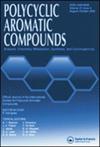潜在抗结核药物氟硫酸芳基衍生物的QSAR建模、分子对接和ADMET研究
IF 2.6
3区 化学
Q2 CHEMISTRY, ORGANIC
引用次数: 0
摘要
由结核分枝杆菌(Mtb)感染引起的结核病是一种全球性传染病,由于其发病率和死亡率高,对公共卫生构成重大挑战。长期使用常规抗结核疗法导致结核分枝杆菌出现严重耐药性,导致治疗时间延长、费用增加、患者依从性差和治愈率降低。这一现象对全球结核病预防和控制工作造成了重大负担,需要将研究重点转向探索新的抗结核药物。在此背景下,我们利用QSAR建模方法,系统地研究了36种氟硫酸芳基衍生物的化学结构与其对结核分枝杆菌的抑制活性之间的关系。Topomer CoMFA和HQSAR模型具有鲁棒性和预测性,Topomer CoMFA模型参数:q2 = 0.659, r2 = 0.969, F = 102.877, N = 6, SEE = 0.138;HQSAR模型参数:q2 = 0.705, r2 = 0.873, SEE = 0.264, HL = 199, N = 4。利用这些模型,利用ZINC15数据库对化合物进行结构修饰,从而成功设计和筛选了三种具有理想抑制活性的新化合物。分子对接和ADMET性能预测结果表明,这三种新化合物具有较强的结合能力和良好的药物潜力。本研究为开发氟硫酸芳基衍生物作为潜在的结核病治疗药物和新药提供了有价值的见解和研究方向。本文章由计算机程序翻译,如有差异,请以英文原文为准。
QSAR Modeling, Molecular Docking and ADMET Study of Aryl Fluorosulfate Derivatives as Potential Anti-TB Agents
Tuberculosis (TB), caused by Mycobacterium tuberculosis (Mtb) infection, stands as a global infectious disease presenting substantial public health challenges due to its high incidence and mortality rates. The prolonged use of conventional anti-TB therapies has led to the emergence of severe drug resistance in Mtb, resulting in extended treatment durations, increased costs, poor patient compliance, and reduced cure rates. This phenomenon has posed a significant burden on global TB prevention and control efforts, necessitating a shift in research focus toward the exploration of novel anti-TB drugs. In this context, utilizing QSAR modeling methods, our study systematically investigated the relationship between the chemical structures of 36 aryl fluorosulfate derivatives and their inhibitory activity against Mtb. Robust and predictive Topomer CoMFA and HQSAR models were developed, featuring Topomer CoMFA model parameters: q2 = 0.659, r2 = 0.969, F = 102.877, N = 6, SEE = 0.138; HQSAR model parameters: q2 = 0.705, r2 = 0.873, SEE = 0.264, HL = 199, N = 4. Leveraging these models, structural modifications were applied to the compounds using the ZINC15 database, leading to the successful design and screening of three novel compounds with desirable inhibitory activity. Molecular docking and ADMET performance prediction results indicated that these three new compounds exhibit strong binding capabilities and promising pharmaceutical potential. This study provides valuable insights and research directions for the development of aryl fluorosulfate derivatives as potential agents for tuberculosis treatment and as novel drugs.
求助全文
通过发布文献求助,成功后即可免费获取论文全文。
去求助
来源期刊

Polycyclic Aromatic Compounds
化学-有机化学
CiteScore
3.70
自引率
20.80%
发文量
412
审稿时长
3 months
期刊介绍:
The purpose of Polycyclic Aromatic Compounds is to provide an international and interdisciplinary forum for all aspects of research related to polycyclic aromatic compounds (PAC). Topics range from fundamental research in chemistry (including synthetic and theoretical chemistry) and physics (including astrophysics), as well as thermodynamics, spectroscopy, analytical methods, and biology to applied studies in environmental science, biochemistry, toxicology, and industry. Polycyclic Aromatic Compounds has an outstanding Editorial Board and offers a rapid and efficient peer review process, as well as a flexible open access policy.
 求助内容:
求助内容: 应助结果提醒方式:
应助结果提醒方式:


